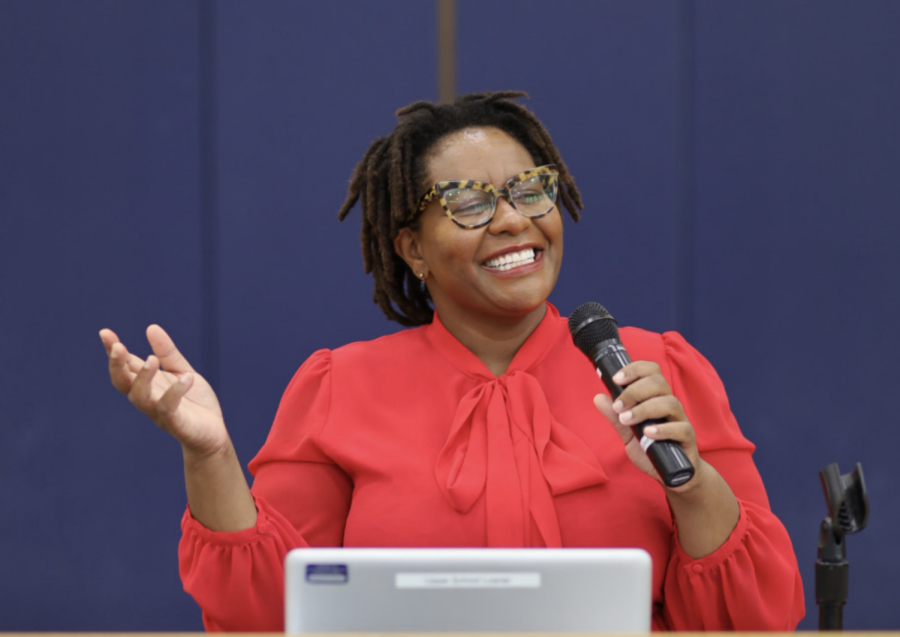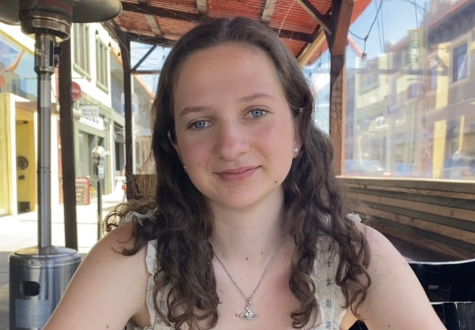Faculty reflect and look ahead at trauma training
Hamilton brings wisdom and spurs discussion
October 13, 2021
At an all-faculty meeting before the start of the school year, Brandeis University Diversity, Equity, and Inclusion (DEI) Director of Programming Aretina Hamilton instructed faculty to turn to the people around them and give a personal answer to the question, “How are you?” She asked for more than just the expected, “I’m fine.”
This prompt opened faculty’s August 31 conversation about the importance of a trauma-informed campus and how to navigate racism at school. From here, faculty members shared their personal feelings about last year, and Dr. Hamilton guided them through a discussion of what it means to be a trauma-informed campus and how racial identity shapes peoples’ lives. The talk centered on student experiences and on the importance of teachers reflecting and checking on themselves.
“Dr. Hamilton encouraged people to look out for their own self-care,” Upper School (US) History and Social Sciences Teacher Matt Turnbull said. “It’s the idea that if you’re going to be there for your students, you have to also be in a good place for yourself.”
Prior to this meeting, faculty members were asked to read two articles: “Essential Trauma-Informed Teaching Strategies for Managing Stress in the Classroom” and “Addressing Anti-Blackness and the Trauma of the Past and Present.” According to the former, being trauma-informed is a “commitment to learning more about trauma and viewing the individual as a person and not their behavior.” The article promotes transparency, safety, and collaboration as key to creating a trauma-informed campus.
Dr. Hamilton wrote the second article and argues in it that whiteness “pervades our curriculum, our culture, our traditions, our personal relationships, and our social networks” at independent schools. She calls for inclusivity, community building, and the amplification of Black voices.
“The articles were overviews reminding teachers that for many students, there have been a lot of things going on in the past year or two that can create a great deal of stress,” Mr. Turnbull said. “COVID was one big one that we all experienced together, but we are also living in a period of racial reckoning. To varying degrees, members of our community felt the weight of police shootings and political protests and the intense conversations about racism in America.”
For him, Dr. Hamilton’s discussion was useful because it reminded him that everyone is experiencing life through different lenses, he said.
“The goal was to remind ourselves that all our students are people, too, outside of the classroom, and that affects how they show up in class,” Mr. Turnbull said. “How we interact with them will affect how they respond to our teaching.”
Head of School Jen Price said the difficulties of the past year have been evident, and hearing from Dr. Hamilton was an important way to address community members’ well-being.
“We all need to understand that what we have been through for the last 18 months has been traumatic for many people,” she said. “Part of our work as a school is to acknowledge the strain that has had on members of our community, including students, and to think about how we can support our students socially and emotionally and ensure that they are prepared to learn.”
US Math and Computer Science Teacher Agnes Voligny said being trauma-informed means acknowledging the challenges of the past year and remembering that people are still adjusting to the pandemic, which means the need to connect with students is even more critical.
Some of the changes Ms. Voligny has made over the past few years to embody a trauma-informed approach, she said, have been discussing a growth mindset with students, offering revision and retake options, and giving more group work.
“When we were all 100% remote, I broke people up in groups and they worked together, learned from each other, and connected, which made learning about connecting not just somebody giving you information and processing it on your own.”
US History and Social Sciences Department Head Susan Glazer said she prioritizes open communication with her students and a mutual understanding that it’s important to speak up when challenges arise.
“I’m finding ways to open the conversation and create space for students to really share how they’re really doing,” she said. “I do little check- ins with my seniors, a lot of journaling, and I’m building relationships where students can pop up and share in or out of class.”
Community Outreach and Engagement Specialist Candie Sanderson said discussions are just as important as the typical scheduling and logistics meetings that occur at the start of the year.
“This meeting set the tone so that everyone’s on the same page around how we’re thinking about the year, why we believe these things are important, and why we are asking everyone to commit to self-reflection in professional development so that they can support students and adults through this time,” she said.
Looking to the future, Ms. Sanderson said she wants to leverage the school’s momentum around principled engagement to encourage student leadership initiatives and empower students to help build community, particularly in ways that provide support for historically marginalized groups.
“During the pandemic, instead of just turning inward and saying this is hard, students actually turned outward and really helped each other and people beyond the BB&N community,” she said, citing Letters Against Isolation and Boston-COVID Tutoring as examples (See “Sisters launch card campaign,” Vol. 49, No. 1 and “Junior founds online tutoring service,” Vol. 49, No. 3). “I’m thinking about how I can help empower students so that it’s not just something they do on the side but something that they feel they have institutional support behind.”
Diversity, Equity, Inclusion & Global Education Officer Leila Bailey- Stewart, who coordinated the event with Chief Learning Officer Jed Lippard, said while Dr. Hamilton’s discussion with faculty met the goal of being engaging and relevant, working on being trauma- informed with the whole community is a necessary next step.
“Some of the best work at BB&N is advanced by having student voices, participation, and leadership,” she said. “It is our responsibility as faculty, staff, and administration to ensure that we continue to create opportunities for students to make meaning of topics like this and more.”


